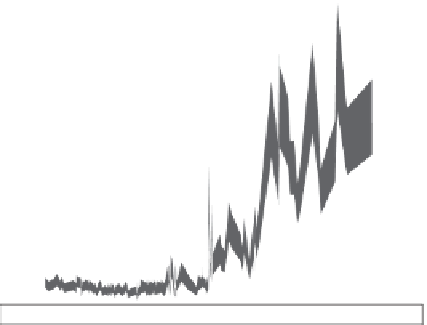Geoscience Reference
In-Depth Information
2500
2000
Alkenone
record
1500
1000
500
Miocene
Oligocene
Eocene
0
0
5
10
15
20
25
30
35
40
45
50
Age (millions of years ago)
Figure 9.5
13
C of alkenones. The global trend of
oceanic cooling since the end of the Cretaceous is particulary visible for the deep ocean (see
previous figure). It reflects a drop in atmospheric CO
2
and therefore a decline of the greenhouse
Atmospheric pressure of carbon dioxide deduced from the
δ
13
C of alkenones is a reliable indicator of atmospheric pressure of car-
bon dioxide, this cooling is probably associated with a drop in
P
CO
2
by a factor of four
(
Fig. 9.5
). The strong decline of the greenhouse effect over the last
Inasmuch as
δ
55 Ma therefore
explains the global cooling of the planet and the advent of the “icehouse” thermal regime.
Carbon dioxide is injected into the atmosphere by volcanoes. Erosion then transfers it to
the hydrosphere by reactions similar to those described by
(7.30)
above. It is then removed
from the ocean by precipitation of carbonate and by sedimentation in the form of reduced
carbon (kerogen, petroleum, or coal). Some of the reduced organic carbon in the sediment
is re-oxidized as CO
2
by oxygen in the air when rocks are exposed by erosion; the naturally
occurring oil seeps of hydrocarbon-rich areas of California and the Persian-Arabian Gulf
are evidence of this. Human activity is accelerating this process through the burning of
fossil fuels in power plants and transport. Some of the sedimentary carbonates are removed
from the surface system via subduction zones, but we do not know exactly how much of
this CO
2
is returned to us by decarbonation at depth and orogenic volcanism in those parts
of the world. It appears, however, that the quantity of carbonates at the Earth's surface has
increased significantly over geological time.
How atmospheric
P
CO
2
can have changed so much over 70 Ma is still somewhat under
discussion. One hypothesis is that fluctuations in volcanic emissions of CO
2
forced the
system. The Cretaceous was indeed a period of intense volcanic activity. The rapidly
widening rifts of the dislocating Pangea supercontinent were preceded by strong bursts
of volcanic activity such as the Ontong-Java oceanic plateau in the Western Pacific, the
Caribbean-Columbia plateau, the Rajmahal and Deccan traps in India, and the Paraña-
Etendeka traps of South America and South Africa. The greenhouse effect was very
≈




























